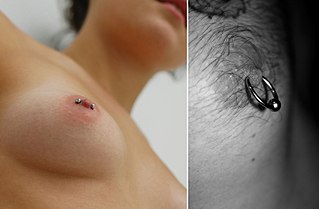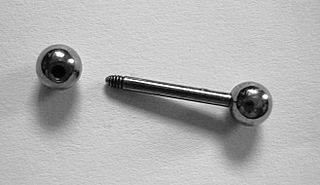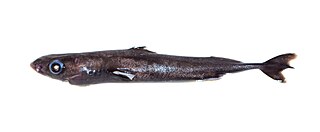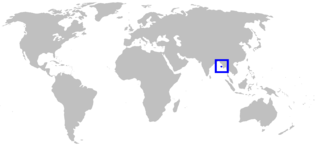This is a comprehensive list of different parts for body piercing.
This is a comprehensive list of different parts for body piercing.

A lip piercing is a type of body piercing that penetrates the lips or the area surrounding the lips, which can be pierced in a variety of ways.

The navel is a protruding, flat, or hollowed area on the abdomen at the attachment site of the umbilical cord. All placental mammals have a navel, although it is generally more conspicuous in humans.

Rhinoplasty, commonly called nose job, medically called nasal reconstruction, is a plastic surgery procedure for altering and reconstructing the nose. There are two types of plastic surgery used – reconstructive surgery that restores the form and functions of the nose and cosmetic surgery that changes the appearance of the nose. Reconstructive surgery seeks to resolve nasal injuries caused by various traumas including blunt, and penetrating trauma and trauma caused by blast injury. Reconstructive surgery can also treat birth defects, breathing problems, and failed primary rhinoplasties. Rhinoplasty may remove a bump, narrow nostril width, change the angle between the nose and the mouth, or address injuries, birth defects, or other problems that affect breathing, such as a deviated nasal septum or a sinus condition. Surgery only on the septum is called a septoplasty.

An earring is a piece of jewelry attached to the ear via a piercing in the earlobe or another external part of the ear, or, less often, by some other means. Earrings have been worn in diverse civilizations and historic periods, often carrying a cultural significance.

An erogenous zone is an area of the human body that has heightened sensitivity, the stimulation of which may generate a sexual response, such as relaxation, sexual fantasies, sexual arousal and orgasm.

Genital piercing is a form of body piercing that involves piercing a part of the genitalia, thus creating a suitable place for wearing different types of jewellery. Nevertheless, the term may also be used pars pro toto to indicate all body piercings in the area of the anus, perineum, penis, scrotum, and vulva, including piercings such as anal, guiche, and pubic that do not involve perforation of genitalia. Genital piercings can be done regardless of sex, with various forms of piercings available. The main motive is beautification and individualization; in addition, some piercings enhance sexual pleasure by increasing stimulation. Pre-modern genital piercings is most culturally widespread in Southeast Asia, where it has been part of traditional practice since ancient times. Records of genital piercing are found in the Kama Sutra.

A nipple piercing is a type of body piercing, centered usually at the base of the nipple. It can be pierced at any angle but is usually done horizontally or, less often, vertically. It is also possible to place multiple piercings on top of one another.

Surface piercings are piercings that are found on flat parts of the body, giving a double-pierced look that sits flat against the skin. A surface bar follows the plane of skin, while a standard piercing is pierced through the plane. Standard piercings have an entrance hole with an exit hole that is usually directly behind the entrance hole, whereas with a surface piercing the entrance and exit holes are next to each other on the skin surface.
Body piercing jewelry is jewelry manufactured specifically for use in body piercing. The jewelry involved in the art of body piercing comes in a wide variety of shapes and sizes in order to best fit the pierced site. Jewelry may be worn for fashion, cultural tradition, religious beliefs, personal symbolism, and many other reasons.
Otoplasty is a procedure for correcting the deformities and defects of the auricle, whether these defects are congenital conditions or caused by trauma. Otoplastic surgeons may reshape, move, or augment the cartilaginous support framework of the auricle to correct these defects.

Barbell style piercing jewelry is composed of a straight bar with a bead on each end, one or both beads unscrewable for removal and/or changing of the beads. Often one of the beads is fixed, either via epoxy or welding, so that only one bead is used to install or remove the jewelry. Barbell threads are usually right-handed.
Stretching, in the context of body piercing, is the deliberate expansion of a healed piercing for the purpose of wearing certain types of jewelry. Ear piercings are the most commonly stretched piercings, with nasal septum piercings, tongue piercings and lip piercings/lip plates following close behind. While all piercings can be stretched to some degree, cartilage piercings are usually more difficult to stretch and more likely to form hypertrophic scars if stretched quickly. Dermal punching is generally the preferred method for accommodating larger jewelry in cartilage piercings.

An anti-eyebrow is a facial piercing that is placed above the cheek bone or below the eyebrow. Normally it is done with a small surface bar. This piercing can be vertical or horizontal, depending on the person's preference. Though it is a surface piercing, with proper care, placement, and jewelry, it can be a viable long-term piercing. Long-term viability is best with proper surface bars, and significantly reduced when barbells, or curved barbells are used. Often reputable piercers will refuse to do surface piercings, instead preferring sub-dermal implants.
Mastopexy is the plastic surgery mammoplasty procedure for raising sagging breasts upon the chest of the woman, by changing and modifying the size, contour, and elevation of the breasts. In a breast-lift surgery to re-establish an aesthetically proportionate bust for the woman, the critical corrective consideration is the tissue viability of the nipple-areola complex (NAC), to ensure the functional sensitivity of the breasts for lactation and breast-feeding.

The smalleye pygmy shark is a little-known species of squaliform shark in the family Dalatiidae, found in water 150–2,000 m (490–6,560 ft) deep near Japan, the Philippines, and Australia. It migrates vertically daily, spending the day in deep water and the night in shallower water. One of the smallest shark species, the smalleye pygmy shark is known to reach only 22 cm (8.7 in) long. It has a blackish, spindle-shaped body with relatively small eyes, and a spine preceding the first dorsal fin, but not the second. Bioluminescent photophores occur on its underside, which may serve to disguise its silhouette from predators. This species feeds on small squid, krill, shrimp, and bony fishes. It is aplacental viviparous. The International Union for Conservation of Nature has assessed it as Least Concern, citing its wide distribution and lack of threat from fisheries.
A cartilage piercing can refer to any area of cartilage on the body with a perforation created for the purpose of wearing jewelry. The two most common areas with cartilage piercings are the ear and the nose. Many people outside of the body modification community often informally use the term "cartilage piercing" to refer a helix piercing. The cartilage ear piercing is known to be more sore than the lobe as in the cartilage there is less blood so it takes longer to heal.

Body piercing, which is a form of body modification, is the practice of puncturing or cutting a part of the human body, creating an opening in which jewelry may be worn, or where an implant could be inserted. The word piercing can refer to the act or practice of body piercing, or to an opening in the body created by this act or practice. It can also, by metonymy, refer to the resulting decoration, or to the decorative jewelry used. Piercing implants alter the body and/or skin profile and appearance. Although the history of body piercing is obscured by popular misinformation and by a lack of scholarly reference, ample evidence exists to document that it has been practiced in various forms by multiple sexes since ancient times throughout the world. Body piercing can be performed on people of all ages, although most minors are only permitted to have earlobe piercings.

The magnificent catshark or clown catshark is a species of finback catshark, belonging to the family Proscylliidae, known only from five specimens collected in the northern Andaman Sea near the edge of the Myanmar continental shelf. Its common names refer to its distinctive, elaborate color pattern of small and large dark spots, which include "clown faces" beneath each dorsal fin. Reaching 49 cm (19 in) in length, this species has a very slender body with a short, flattened head and a large lobe of skin in front of each nostril. The first dorsal fin is placed behind the pectoral fins but ahead of the pelvic fins.
The Philippines angelshark is a species of angelshark, family Squatinidae, known only from a 33 cm (13 in) long immature female caught in the Philippines, where it is the only known representative of its family. It has a flattened body and head with greatly expanded pectoral and pelvic fins, and is greenish above with brown spots. Identifying traits of this species include the spiracles, which are more widely spaced than the eyes and bear papillae on the posterior inner rims, and the relative positions of the two dorsal fins. Additionally, S. caillieti lacks fringes on its barbels, enlarged thorns along the middle of its back, and ocelli ("eyespots") on its fins.
Open bite is a type of orthodontic malocclusion which has been estimated to occur in 0.6% of the people in the United States. This type of malocclusion has no vertical overlap or contact between the anterior incisors. The term "open bite" was coined by Carevelli in 1842 as a distinct classification of malocclusion. Different authors have described the open bite in a variety of ways. Some authors have suggested that open bite often arises when overbite is less than the usual amount. Additionally, others have contended that open bite is identified by end-on incisal relationships. Lastly, some researchers have stated that a lack of incisal contact must be present to diagnose an open bite.